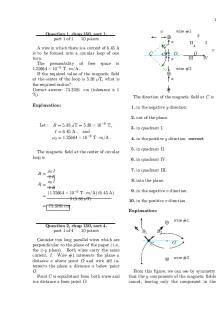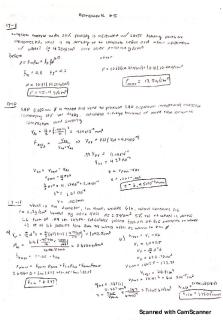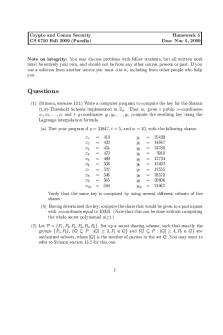Homework 5 PDF

| Title | Homework 5 |
|---|---|
| Course | Quantitative Reasoning And Technological Literacy Ii |
| Institution | DePaul University |
| Pages | 2 |
| File Size | 83.8 KB |
| File Type | |
| Total Downloads | 55 |
| Total Views | 124 |
Summary
Homework 5...
Description
LSP 121 - Homework 5: Logs, Richter scale and Decibels Due: Next Class Go to QRC and save the file logs.xls as a target. You will use this file for both parts below. There are two tabs at the bottom of the worksheet. Use these tabs to access the Richter and Decibels files. 1. Richter scale The Richter scale is used to measure the intensity of earthquakes. It is a logarithmic relationship with the following formula: R = log(I) I is the intensity of the earthquake and R is the number on the Richter scale. (Remember that if there is no base written with the log it is base 10). Don’t be scared off by logs. Think of them as a short-cut way of writing large numbers. For example, let’s say the intensity of an earthquake is 100,000,000. Can you imagine if the papers published that big number? What would people think? Most people cannot handle well numbers with large amounts of zeros (unless those people work for the government ;-). Instead of writing 100,000,000, let’s just write how many zeros there were. In this case, there are 8 zeros. That’s is exactly what log10 is asking. 10 to what power equals 100,000,000? 10 to the 8th power. So the log(100,000,000) equals 8. Thus, the Richter value for an earthquake with intensity 100,000,000 is 8. Let’s say it another way. Let’s remove the log. Converting the above formula from log form to exponent form would give us: 10R = I (Note: 10 was raised to the R power, which cancels the log function.) Which version you use depends on which variable you are given. If you are given the Richter value (R) and want to calculate the intensity, then use 10R = I. If you are given the intensity and want to calculate the R value, use R = log(I). Since the Richter scale is logarithmic, an increase of 1 on the Richter scale translates to 10 times increase in intensity. An R of 2 means an intensity of 100 while an R or 3 has an intensity of 1000 which is 10 times larger than the previous intensity. a) Open the Richter worksheet in the Excel file. For the first 9 earthquakes, calculate the Richter number and for the remaining calculate the intensity using the formulas above. Copy and paste the completed table into your Word document. b) Which earthquake had the highest Richter number?
c) Is there a correlation between Intensity and number of deaths? (Remember you can calculate the correlation in Excel with =rsq(array1, array2)). That is, as the intensity of the earthquakes increased, did the number of deaths increase? Why do you think that is? d) If one earthquake had a Richter number of 5 and another had a Richter number of 7, how many times more intense would the second one be than the first? e) If one earthquake had an intensity of 8,000,000 and another had an intensity of 80,000,000 how, specifically, would their Richter numbers compare? 2. Decibels Decibels are a measurement of sound intensity. The logarithmic relationship between intensity of a sound and sound level in decibels is given by the following formula: L = 10 * log (I/Io) L is the sound level in decibels, I is the intensity of the sound, and Io is the intensity of the softest sound that can be heard by humans. I/Io is a ratio. This ratio is how many times louder a sound is than the softest audible sound. For this activity, we will only consider the ratio and not the individual pieces of the ratio. a) Convert the above formula to exponent form. If you need help, remember to first divide both sides by 10. Then perform the same operation that we performed above to convert R = log(I) to 10R = I. b) Open the decibels worksheet. Fill in the empty cells with either the decibels or the ratios of the intensities, using the formula above and the version from part “a”. Copy and paste the completed table into your Word document. c) What does it mean mathematically about the ratio of intensity for one sound to be 10 decibels louder than another sound? d) The following statement is incorrect. “A jet airplane landing at the local airport makes 120 decibels of noise. If we allow three jets to land at the same time, there will be 360 decibels of noise pollution.”
If one jet airplane makes 120 decibels of noise, what would the ratio of intensities be for one plane? What would the ratio of intensities be for all three planes? What would the decibel level be for the three jets? Is it 360 decibels as claimed above?
Hint: Because of the nature of logs, you can’t add the decibel values. Instead, you have to add the intensities. Once you have the cumulative intensity, convert that value to decibels....
Similar Free PDFs

Homework 5
- 2 Pages

Homework 5
- 9 Pages

Homework 5
- 4 Pages

Hoework 5 - homework 5
- 3 Pages

Homework 5
- 2 Pages

HW 5 - Week 5 homework
- 6 Pages

Chapter 5 HW - Homework
- 2 Pages

5 - online homework solution
- 8 Pages

Seminar assignments - Homework 5
- 1 Pages

Hw 11-5 - Homework
- 2 Pages

Hw #5 - homework
- 4 Pages

homework 5 for cs240
- 6 Pages

Homework-5-sln - HW5
- 4 Pages

Homework Chapter 5
- 4 Pages

Unit 5 Homework
- 3 Pages

Homework Solution 5
- 3 Pages
Popular Institutions
- Tinajero National High School - Annex
- Politeknik Caltex Riau
- Yokohama City University
- SGT University
- University of Al-Qadisiyah
- Divine Word College of Vigan
- Techniek College Rotterdam
- Universidade de Santiago
- Universiti Teknologi MARA Cawangan Johor Kampus Pasir Gudang
- Poltekkes Kemenkes Yogyakarta
- Baguio City National High School
- Colegio san marcos
- preparatoria uno
- Centro de Bachillerato Tecnológico Industrial y de Servicios No. 107
- Dalian Maritime University
- Quang Trung Secondary School
- Colegio Tecnológico en Informática
- Corporación Regional de Educación Superior
- Grupo CEDVA
- Dar Al Uloom University
- Centro de Estudios Preuniversitarios de la Universidad Nacional de Ingeniería
- 上智大学
- Aakash International School, Nuna Majara
- San Felipe Neri Catholic School
- Kang Chiao International School - New Taipei City
- Misamis Occidental National High School
- Institución Educativa Escuela Normal Juan Ladrilleros
- Kolehiyo ng Pantukan
- Batanes State College
- Instituto Continental
- Sekolah Menengah Kejuruan Kesehatan Kaltara (Tarakan)
- Colegio de La Inmaculada Concepcion - Cebu